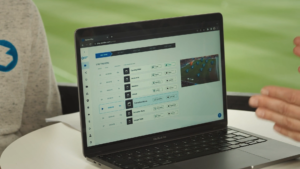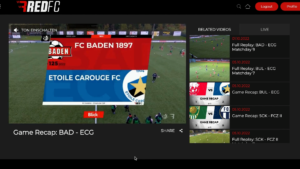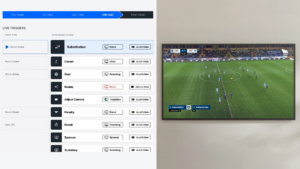Expanding the Limits of Broadcasting: The 4 Key Trends Making Autocasting the Next Revolution in Sports Consumption
Story Highlights
Autocast, Verb; the process of using automation for all production elements for sports broadcasts at a large scale, across all levels.

In 1979 – when ESPN transformed sports media forever – the broadcasting industry went through a revolution. Broadcasts went from tape delay to live; and the status quo for monetizing and distributing sports to any household that wanted it, was established.
With that, eventually came the explosion of money in sports, where top tier leagues, conferences, and organizations began to sell their media rights in exchange for millions, if not billions, of dollars.
But the revolution is not reserved for the best of the best in 2022. There is an ongoing global transformation for how sports is produced and consumed on all levels.
Autocasting, automatic production, and connectivity is at the heart of this transformation, making games available that would otherwise be unavailable for consumption. At Spiideo, we’ve identified 4 key trends for how this transformation is playing out:
1. All played games will be accessible online At both scale and an individual level. From local clubs to entire federations, rights-holders and clubs are utilizing technology to broadcast games that would otherwise be unavailable.
Whether that’s Gothia Cup, Ringier Sports, MLS NEXT PRO, or Forjães SC, these organizations are ensuring that all games are accessible to fans.

2. Everyone in sports will utilize video analysis tools
Through the same automated camera system, teams and leagues automatically have panoramic and broadcast versions of their games instantly available for analysis. Video analysis is no longer reserved for the top-tier teams, but affordable and accessible at every tier of sport. With this, the product on the field improves, players excel, and rights-holders hold an additional card to be played when their bid is submitted.
3. Content rights are being acquired in mid-level sports across the globe
Ringier Sports perfectly exemplifies what mid-level sports can offer when combined with the right technology. Through data and video, Ringier built RED, an automated and multi-faceted streaming platform for football fans across Switzerland. Game events automatically trigger broadcast graphic enhancements and each production is automated with set run-sheets for lineups, camera movements, video ads, and more. Highlights are automatically packaged and then shared across various channels.
4. The way sports is consumed will change from linear full games to interactive experiences
and efficient consumption
Through the increased coverage of games, automatic highlights and interactive graphics, fans will gain improved accessibility and more immersive viewing experiences, in shorter time formats. Post-production automation enables discoverability and engagement for the fans.
How Autocasting Expands the Possibilities for Rights-Holders
International movie star and Wrexham AFC owner, Ryan Reynolds, recently drew attention to the Vanarama National League’s refusal to allow teams competing in the English fifth tier to stream their matches:
“After months of maximum effort, the decision (through inaction of the Vanarama National League) to not allow domestic/international streaming of matches of Wrexham and the other clubs in the league is truly baffling,” Reynolds Tweeted. Evidently, the league’s media partner hasn’t seen the ROI required to broadcast more than 30 National League games a year. But why?

While Reynolds and Wrexham AFC may be able to afford a broadcast crew for the club, it’s clear that their media partner lacks the incentive to send production trucks to many of the games in the Vanarama National League. But through automated fixed camera systems and a cloud-based sports production platform, it’s possible for all 24 teams in the league to easily autocast matches that don’t have the viewership of the Premier League, the NBA or La Liga.
And by setting the scene for viewers that the alternative is no broadcast at all, organizations can mitigate the expectations surrounding autocasts. Autocasts still feature professional graphics, commentators, and enhancements, but may lack the 20+ camera set up viewers are used to when Liverpool play Chelsea.
Where Can Autocasting Be Deployed in the Sports Pyramid?
Despite the sport industry’s complexity, the broadcasting ecosystem can be broadly divided into four tiers, ranging from the industry’s most prestigious clubs and competitions to youth- and grassroots-level events.
Tier 1 is reserved for elite teams and competitions, such as the NFL, Premier League, NBA, La Liga, and MLB. The organizations in this tier are capable of attracting viewership in the millions and lucrative advertisers for every event, offering mass appeal to sports fans at home and the broadcasters bidding to secure their rights. This tier can invest millions in manual, state-of-the-art productions and broadcasts.
Tier 2 consists of all other professional sports leagues and teams, such as the EFL Championship, Major League Soccer, and Euroleague Basketball, as well as top-level college conference sports (football, basketball) in the United States. Tier 2 events still typically attract the interest of major broadcasters, albeit at less lucrative rates than those offered in the tier above.
Tier 3 is made up of semi-professional sports clubs and leagues, as well as professional youth academies and competitions, such as the Sun Belt Conference, UEFA Youth League, and Baseball-Bundesliga. While there is plenty of interest at this level, it has historically been rare for tier 3 events to attract the interest of major broadcasters and media partners.
Tier 4 includes those at the lowest levels of the sporting pyramid, such as youth clubs and leagues, high school competitions, and grassroots sport. While these events often attract small crowds, typically made up of parents, friends, and family, they do not offer the mass appeal to attract traditional broadcasters.

As a result, while the sports industry continues to generate billions of dollars through lucrative broadcasting contracts – estimated at $52.1bn in 2021 according to SportBusiness – the riches are likely confined to those at the very top of the pyramid. Throughout the 2019-20 season, for instance, the five largest sports leagues generated $15.4bn in broadcasting revenue alone, equal to 30% of SportBusiness’ total estimate. And while autocasting will have the biggest impact on tiers 2-4, it can also play a role for tier 1 to autocast friendlies, academy games, and farm/minor league fixtures.
The emergence of autocasting will not cut in the pie of sports broadcasting, but rather expand it. Media companies have begun to acquire rights for sports in the lower tiers and are using scalable technology to generate the ROI that is required.
With autocasts featuring automated camera operators, remote commentators, triggered professional graphics, and cloud-based tools for managing the operation, it’s become seamless for rights-holders to scale to hundreds, if not thousands of venues at the same time.
Why shouldn’t every game be broadcast for consumption?
